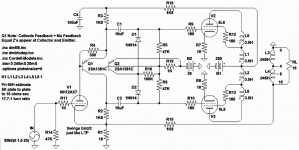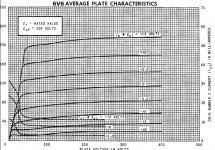That should work well too. Pete made a "mistake" board that was the predecessor for the compactron board. I got a pair, and hacked up the plating to make them into something that looks a lot like the current schematic. I used a triple triode tube that I had several of. It might have been the 6AC10. I used it for a while driving 13GB5's through G1. It worked quite well.
Before that I was using Pete's push pull driver board. That one used a 6J4 triode and a pair of 6HB6's in LTP. It worked great until I accidentally put the banana plug in upside down and ran 400 volts through it backwards. Again 13GB5's through G1.
Both of those boards were great at driving 13GB5's through G1, and would do well with any of the typical audio tubes, but I wanted to feed G2. Both boards were built with 450 volt caps, and I need a bit more.
My lab is all packed away in boxes and will be for several more months, so there will be no experiments for a while. I have my computer hooked up, so I can do simulations, and lay out PC boards. There will be a few boards to test once the lab is back together.
Before that I was using Pete's push pull driver board. That one used a 6J4 triode and a pair of 6HB6's in LTP. It worked great until I accidentally put the banana plug in upside down and ran 400 volts through it backwards. Again 13GB5's through G1.
Both of those boards were great at driving 13GB5's through G1, and would do well with any of the typical audio tubes, but I wanted to feed G2. Both boards were built with 450 volt caps, and I need a bit more.
My lab is all packed away in boxes and will be for several more months, so there will be no experiments for a while. I have my computer hooked up, so I can do simulations, and lay out PC boards. There will be a few boards to test once the lab is back together.
Mosfets aren't the only way to drive AB2 without blocking.
PNP splitter is another interesting story. But this deblocker
averages the bias, compares it to a reference (BE voltage).
If average bias is found to be too low, it pulls up only the
grid of the tube presently in cutoff.
Never built it, so take with a grain of salt.
PNP splitter is another interesting story. But this deblocker
averages the bias, compares it to a reference (BE voltage).
If average bias is found to be too low, it pulls up only the
grid of the tube presently in cutoff.
Never built it, so take with a grain of salt.
Attachments
There is an example in the data sheet with a 9K load, cathode bias, and a 360 volt supply. Start there.
I see that 9k load impedance example in the 1957 RCA datasheets
 I used a 5k (75mA) load on my secondaries of PT and the voltage is 375. Should work just fine, all I see is an increase in THD using the 9k example, should be good for 25 watts.
I used a 5k (75mA) load on my secondaries of PT and the voltage is 375. Should work just fine, all I see is an increase in THD using the 9k example, should be good for 25 watts. Want an excellent, but somewhat complicated amp, look here. I had 6L6GA's in it, smoked glass RCA's from the 40's too, but I used a 6600 ohm OPT.
http://www.diyaudio.com/forums/tubes-valves/133034-6l6gc-ab2-amp.html?highlight=6l6gc+ab2
Thanks I will read through this thread for ideas🙂
Using inspiration from George's 6L6GC AB2 thread and some new boards from Pete Millett, I started a thread a couple of weeks ago here:
http://www.diyaudio.com/forums/tube...riode-push-pull-driver-pcb-6l6gc-ab2-amp.html
No comments yet, but if anyone wants to weigh-in that will motivate me to continue the thread. There are many ways to implement a driver stage, I just happened to want to experiment with Compactrons. The little AB2 Driver Boards are sure convenient and could be used for alot of different scenarios.
I agree the boards are great! I will download the .asc file from your thread and participate. As soon as I sketch out a schematic I will put together a simulation .asc file and post it for the pros to take a look.
Provided one uses new tubes will full emission, 6V6 will just work fine in A2 or AB2. I have all sorts of 6V6 (namely: Sylvania VT-107B coke bottle with grey coated glass, US Navy RCA's 6v6 GTY with coated glass and true micanol brown base, 6v6GTA Fivre with black coated bigger glass and Reflector 6V6GT with black coated glass) I haven't found any issue for HiFi use. No need of protecting the grid and the usual DC coupled CF (or MOSFET source follower is you prefer) without any limiting resistor worked best. Actually I think that A2 or AB2 are the best solutions to get some efficiency in triode connection. With a plate voltage of 300-320V one can achieve 2.5-3W in SE, twice as that in PP A2 (with much lower THD) and easily up to 10W in AB2.
Thanks for the response, its looking like the 6V6's will be fine for audio playback when a source follower is used to drive them, I think the advice to be careful when sine wave testing for power out not to fry the grids is good advice. Although do plan to drive the amp hard😀
I have seen 6L6 datasheets with class AB2 design center values and maximum rating specifications but not for 6V6, the datasheets I have for 6V6 is Tung-Sol and General Electric.
Can the 6V6 be operated in either A2 or AB2 without any issues? The reason I ask is because I have plenty of 6V6GT and 6L6GB bottles but I only have the iron for 6V6. I have a 330-0-330 power transformer w/ 5V and 6.3V taps and push pull output transformers 8k/8ohm.
Of course it can. The spec sheet has a plate characteristic that goes +15V above the VGK= 0 curve (attached). 6V6-oids have also frequently been used as Class C power amps, either as drivers or frequency multipliers.
You'll need a Class AB2 loadline, as the RCA manual doesn't provide any examples of this.
Back in "the day" Class *2 wasn't favoured for audio amplification since they didn't have MOSFETs for grid drivers. Also, you can get as much, and more, audio power from different types that can stay in Class A or AB1, so I don't suppose they considered it important. Unlike the 6L6, there is no "RF" 6V6-oids comparable to the 807.
Draw up a loadline and go for it. These days, grid drivers aren't a problem.
Attachments
Yes, it was not a choice back in the days because of plenty of "easy" alternative solutions for that sort of power output. A 6V6 will draw a lot more grid current than, say, a 45 when driven positive. However the voltage swing is a lot less than a 45 and so even a carefully designed CF can be good enough.
- Status
- Not open for further replies.

